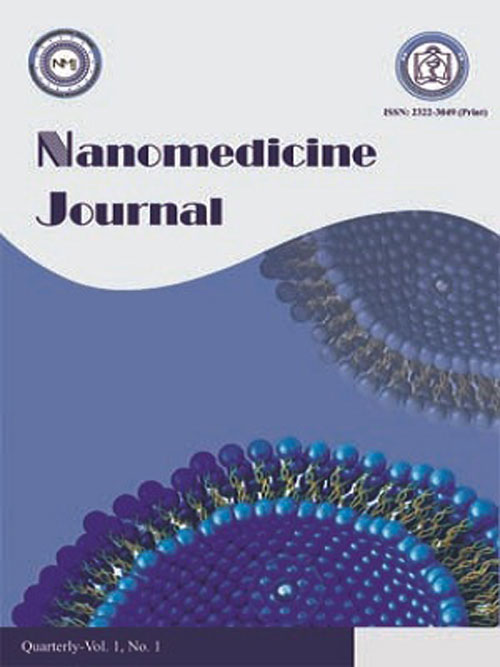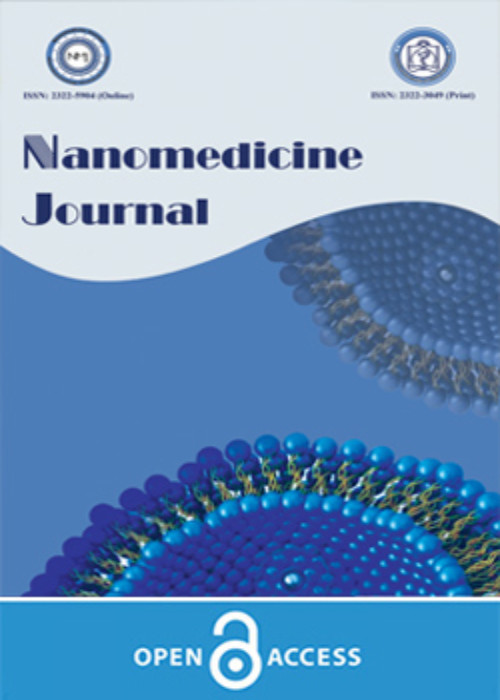فهرست مطالب

Nanomedicine Journal
Volume:2 Issue: 1, Winter 2015
- تاریخ انتشار: 1393/08/05
- تعداد عناوین: 8
-
-
Pages 1-20Gene therapy as a modern therapeutic approach has not yet advanced to a globally-approved therapeutic approach. Lack of adequate reliable gene delivery system seems to be one of the major reasons from the pharmaceutical biotechnology point of view. Main obstacles delaying successful application of human gene therapy are presented in this review. The unique advantages of non-biological gene carriers as compared to their biological counterparts make them ideal alternatives for overcoming extra- and intracellular barriers in a more safely manner. We, therefore, highlight the significant contributions in non-biological gene delivery and favorable characteristics of different design attitudes with focus on in vivo approaches. Bypassing the rapid extracellular enzymatic degradation of genetic materials is covered in extracellular segment of this review with emphasis on PEGylated and targeted formulations. The successful approaches to pave the rest of the way from cellular uptake to intracellular transfer and gene expression of unpacked DNA are also discussed. From these approaches, we emphasize more on optimization of cationic-based polymers and dendrimers, developing newly designed membrane-effective components, and adjusting the hydrophilic-hydrophobic balance of the synthesized vectorsKeywords: Gene delivery, Non, viral carrier, Obstacle, Structural modification
-
Pages 21-28Objective(s)The objective of this study was to determine the cytotoxic effects of nanoliposomal form of lyophilized aqueous extract of Agrostemma githago (A. githago) seeds on gastric cancer cell line (AGS) using cell viability tests.Materials And MethodsLyophilized aqueous extract of A. githago seeds was prepared. Liposomes were also prepared by thin-film hydration method and their stability and size were characterized by SEM. The size and zeta potential were determined by Malvern Zetasizer. Cytotoxic effects of nanoliposomes on gastric cancer cell line was determined using MTT, Neutral Red and Frame methods.ResultsThe size of liposomes was around 171.5 nm with proper dispersion (PDI=0.268). The morphology of the liposomes was suitable according to SEM images. The IC50 values indicated that the nanoliposomal form of extract was 3-4 times more active than extract alone. Average IC50 values for extract and liposomal form of extract were 13.02 ± 0.95 and 4.43 ± 1.49 ug/ml, respectively.ConclusionThis study showed that liposomal form of aqueous extract of A. githago seeds exerts cytotoxic effect at significantly lower concentrations than the extract itself.Keywords: Agrostemma githago, Cytotoxicity, Gastric cancer, Nanoliposome
-
Pages 29-38Objective(s)The introduction of nucleic acids into cells for therapeutic objectives is significantly hindered by the size and charge of these molecules and therefore requires efficient vectors that assist cellular uptake. For several years great efforts have been devoted to the study of development of recombinant vectors based on biological domains with potential applications in gene therapy. Such vectors have been synthesized in genetically engineered approach, resulting in biomacromolecules with new properties that are not present in nature.Materials And MethodsIn this study, we have designed new peptides using homology modeling with the purpose of overcoming the cell barriers for successful gene delivery through Bioinformatics tools. Three different carriers were designed and one of those with better score through Bioinformatics tools was cloned, expressed and its affinity for pDNA was monitored.ResultsThe resultszz demonstrated that the vector can effectively condense pDNAinto nanoparticles with the average sizes about 100 nm.ConclusionWe hope these peptides can overcome the biological barriers associated with gene transfer, and mediate efficient gene delivery.Keywords: Biomimetic, Chimeric peptide, Gene delivery, Nanocarrier
-
Pages 39-45Objective(s)Lipid-based nanoparticles (NLP) are PEGylated carriers composed of lipids and encapsulated nucleic acids with a diameter less than 100 nm. The presence of PEG in the NLP formulation improves the particle pharmacokinetic behavior. The purpose of this study was to prepare and characterize NLPs containing MDR1 siRNA and evaluate their cytotoxicity and cellular uptake. MDR1 siRNA could be used in multidrug resistance reversal in cancer therapy.Materials And MethodssiRNAs were encapsulated into NLPs consisted of mPEG-DSPE/DOTAP/DOPE (10:50:40 molar ratio) by the detergent dialysis method. The particle diameters of NLPs and their surface charge were measured using dynamic light scattering. siRNA encapsulation efficiency was determined by an indirect method via filtration and free siRNA concentration determination. NLPs cytotoxicity was investigated by MTT assay. The ability of NLPs for siRNA delivery checked in two human cell lines (MCF-7/ADR and EPP85-181/RDB) by fluorescence microscopy and compared with oligofectamine.ResultsNLPs containing MDR1 siRNA were prepared with the stable size of 80-90 nm and the zeta potential near to neutral. The siRNA encapsulation efficacy was more than 80%. These properties are suitable for in vivo siRNA delivery. NLPs cytotoxicity studies demonstrated they were non-toxic at the doses used. NLPs improved siRNA localization in both cell lines.ConclusionNLPs containing MDR1 siRNA can be a good candidate for in vivo siRNA delivery studies.Keywords: Nanolipoparticles, siRNA delivery, PEG, shielded, Gene therapy, Liposome
-
Pages 46-53Objective(s)Titanium dioxide (TiO2) nanoparticles (NPs) are widely used in commercial food additives and cosmetics worldwide. Uptake of these nanoparticulate into humans by different routes and may exhibit potential side effects, lags behind the rapid development of nanotechnology. Thus, the present study designed to evaluate the toxic effect of mixed rutile and anatase TiO2 NPs on serum biochemical changes in rats.Materials And MethodsIn this study, adult male Wistar rats were randomly allotted into the experimental and control groups (n=6), which were orally administered with 50 and 100 mg/kg body weight of TiO2 NPs. Toxic effects were assessed by the changes of serum biochemical parameters such as glucose, total protein, albumin, globulin, cholesterol, triglyceride, high density lipoprotein, alanine transaminase, aspartate transaminase, alkaline phosphatase, total bilirubin, blood urea nitrogen, uric acid and creatinine. All the serum biochemical markers were experimented in rats, after 14-days of post exposure.ResultsChanges of the serum specific parameters indicated that liver and kidney were significantly affected in both experimental groups. The changes between the levels of total protein, glucose, aspartate transaminase, alanine transaminase and alkaline phosphatase indicate that TiO2 NPs induces liver damage. Significant increase in the blood urea nitrogen and uric acid indicates the renal damage in the TiO2 NPs treated rats.ConclusionThe data shows that the oral administration of TiO2 NPs (<100nm) may lead to hepatic and renal toxicity in experimental rats.Keywords: Nanoparticle, Oral toxicity, Serum biochemical markers, Titanium dioxide, Wistar rat
-
Pages 54-59Objective(s)The aim of this study was to synthesize triangular gold nanoparticles, and then to evaluate their capability for inhibition of Candida albicans secreted aspartyl proteinase 2(Sap2).Materials And MethodsTo synthesize the nanoparticles, hydrogen tetrachloroaurate and hexadecyl trimethyl ammonium bromide were incubated in presence of Sn(IV) meso-tetra(N-methyl-4-pyridyl) porphine tetratosylate chloride, and then characterized. Next, thirty clinical isolates of Candida albicans were obtained from patients suffering from vaginal candidiasis. Each Candida albicans isolate was first cultured in YCB-BSA medium, incubated for 24 h at 35 ºC. Then, 100 µL of triangular gold nanoparticles at three concentrations (16, 32, and 64 µg/mL) were added to Candida suspension, and incubated for 24 and 48 h at 35 ºC. To evaluate Sap activity, 0.1 mL of medium and 0.4 mL of 0.1 M sodium citrate buffer (pH 3.2) containing BSA 1% w/v were added, and incubated 15 minutes at 37 ºC. Then, the optical density of each tube was read at 280 nm. Enzyme activity was expressed as the amount (µM) of tyrosine equivalents released per min per ml of culture supernatant.ResultsThis study showed that the size of the nanoparticles was 70±50 nm. Sap activity evaluation demonstrated triangular gold nanoparticles could inhibit the enzyme, and the higher incubation time and concentration led to more decrease of Sap activity.ConclusionFor the first time, we demonstrated triangular gold nanoparticles as a novel inhibitor of Sap enzyme which may be useful for treatment of candidiasis.Keywords: Candida albicans, Peptide ligand, Secreted aspartyl proteinase, Triangular gold nanoparticles
-
Pages 60-66Objective(s)The effect of silica nanoparticles (SNPs) in sport shoes outsoles on the parameters related to anterior cruciate ligament (ACL) Injury has not been investigated. The aim of this study was to investigate the effect of shoes outsole containing a composite of thermoplastic elastomer based on styrene-butadiene and silica nanoparticles (TPEN shoe) on Knee Valgus Angle (KVA) as a risk factor of ACL injuries during landingMaterials And MethodsFourteen active healthy women without knee injuries and disorders performed bilateral drop jump (DJ) and single leg drop landing (SLL) tasks in barefoot, wearing shoes fabricated with polyvinyl chloride outsole (PVC shoe) and TPEN shoes conditions, randomly. The knee valgus angle values of right and left legs were calculated in the landing conditions. Two factors repeated measures ANOVA were used to investigate the effect of landing and footwear conditions on KVA of right and left legs.ResultsFor both left and right limbs, the KVA was at maximum and minimum values during landing with barefoot and TPEN shoes, respectively. PVC shoe significantly reduced the knee valgus by 3.84% in left and 4.18% in right knee (P<0.05) as compared to barefoot landing. In a similar pattern, TPEN shoe significantly reduced the knee valgus compared to barefoot by 7.82% and 9.71% in left and right limbs, respectively. Moreover, the knee valgus during DJ was significantly increased as compared to SLL condition (P<0.05).ConclusionShod landing and specially TPEN shoe decreases KVA compared to barefoot. Our results suggested that using SNPs could produce some viscoelasticity property and a better joint movement control in shoe outsoles which can reduce KVA and consequent reduction of ACL Injury.Keywords: Knee valgus angle, Landing, Nanoparticles, Shoe, Silica
-
Pages 67-73Objective(s)This study aimed to determine the possible toxicity of Cuo nanoparticles (NPs) on Oncorhynchus mykiss by evaluating hematological parameters.Materials And MethodsFish were sampled and treated in 4 aquariums containing the concentration ranges of 1, 5, 20 and 100 ppm of CuO NPs. There was one control group (no CuO NPs) and three replicates. The physicochemical properties of water were as follows: the temperature was 22±2 Cº, oxygen saturation was 90.9±0.2%, pH was at 7±0.004 and the concentration of CaCO3 was 270.ResultsNo mortality was observed after 96 hours of exposure. The analysis of hematological parameters showed that CuO NPs affected the counts of white blood cells, lymphocytes, eosinophils, neutrophils, hematocrits, MCH, MCHC and MCV and did not have any effects on monocytes and hemoglobins.ConclusionThe data showed that the overall hardness (270 ppm) neutralized the lethal effect of copper on O. mykiss and no mortality was recorded.Keywords: Copper nanoparticles, Fish, Hematological parameters, Lethality


